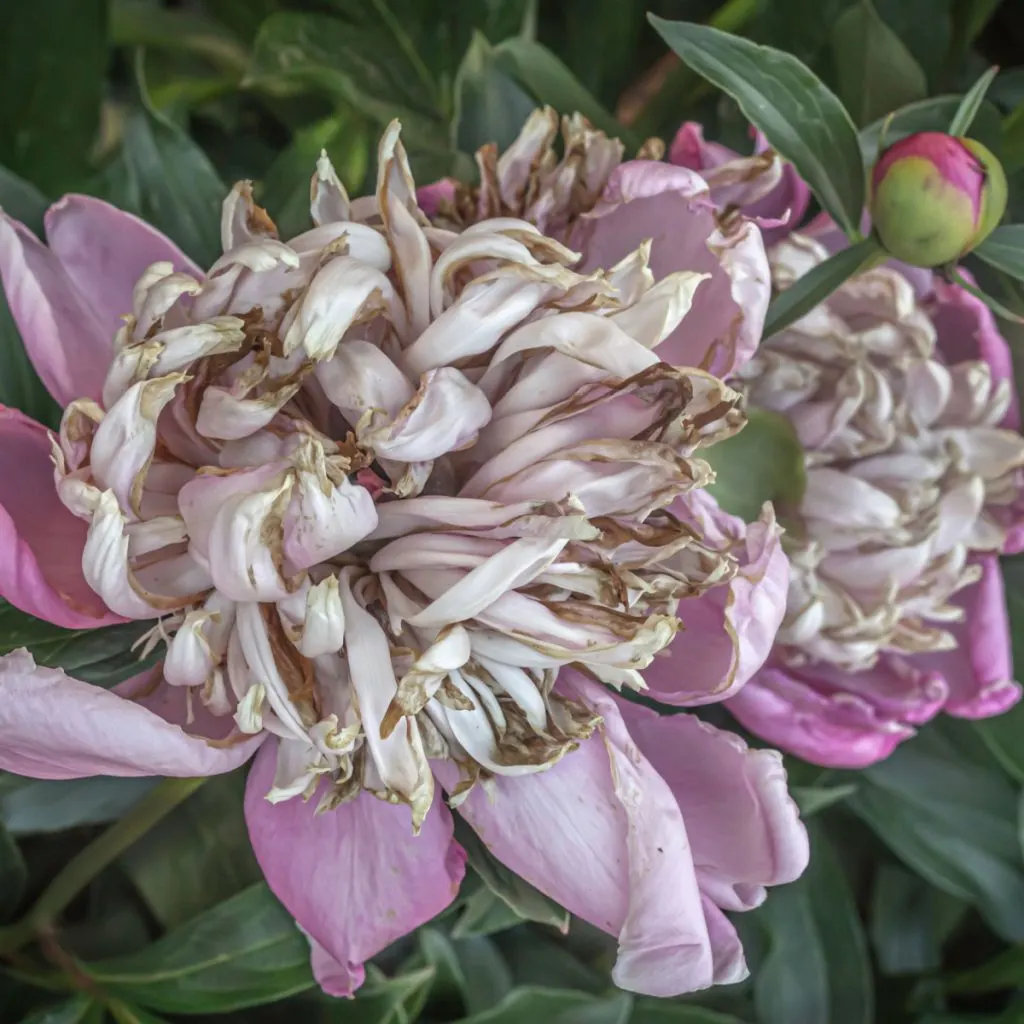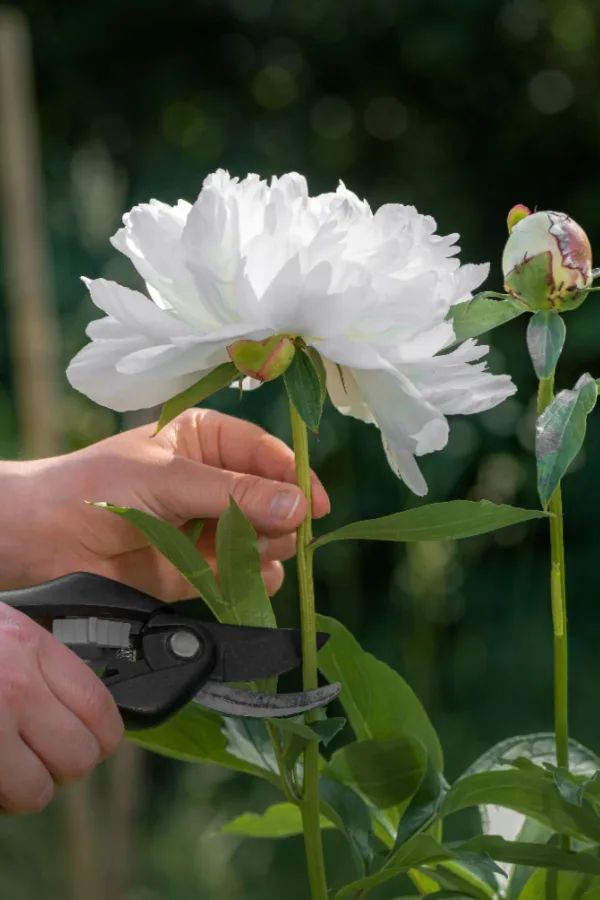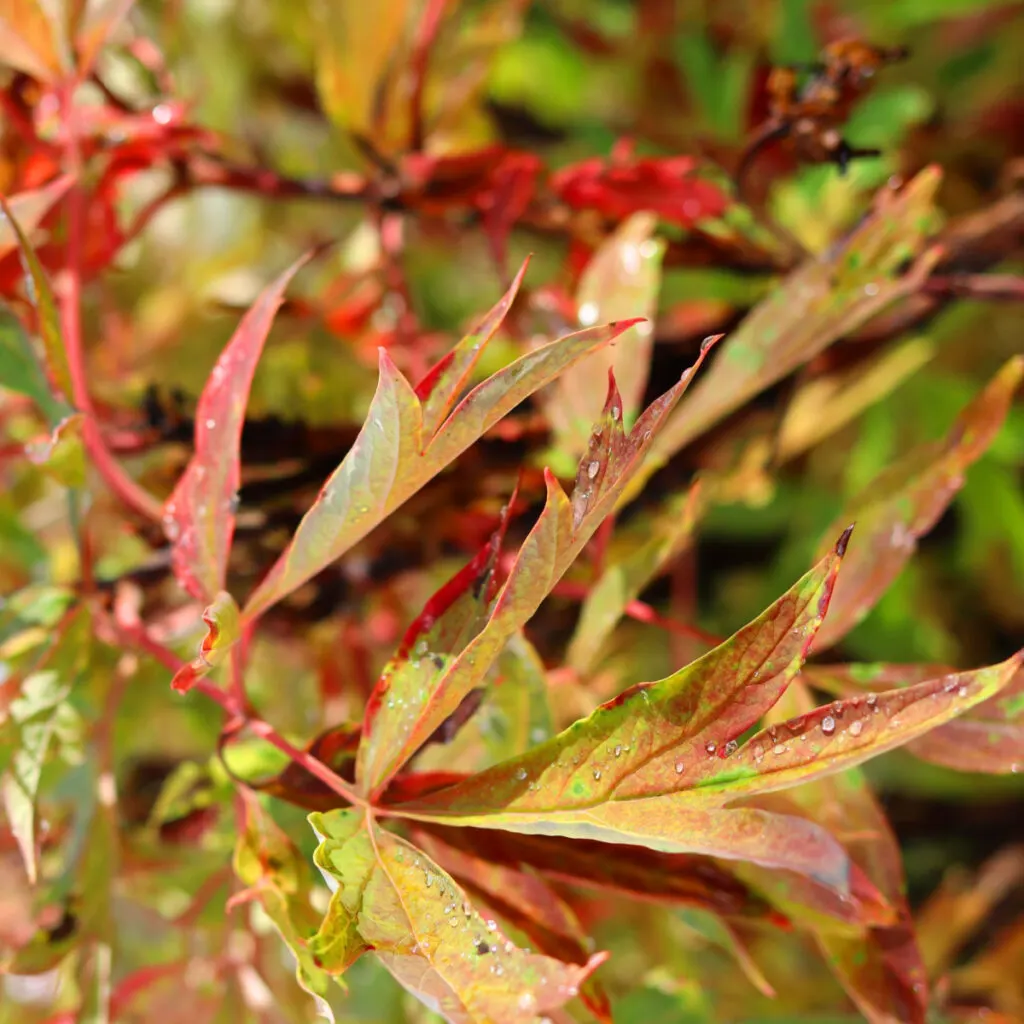Wondering what to do with your peony bushes after they finish blooming late this spring?
Believe it or not, what you do with your peonies after they stop flowering can make a huge difference in just how healthy they will stay for the remainder of the summer. And even more – in just how well they will bloom next year!
Peonies grow in a wide range of climates, which makes them quite a popular choice popular for gardeners looking for big spring blooms. In fact, they are actually winter hardy from growing zones 3 all the way up to zone 8, providing big flower power in a wide range of areas.

But even with their massive popularity, there is a lot of confusion about how to care for peonies after they complete their blooming cycle. Should they be cut back? Is it okay to prune them back? And do they need to be fertilized or not?
All of the above questions are certainly great ones. And the answers to them really can make a huge difference for the health and well being of your peony bushes – even more so when it comes to getting them to flower bigger than ever next spring!
With late spring peony care in mind, here is a look what to do with these gorgeous bushes once their flowers start to fade.
What To Do With Peony Bushes After They Finish Blooming
There are actually two distinct varieties of peonies – peony bushes, and peony trees. Tree peonies are a larger, woody perennial that continue to grow and produce each season from the previous year’s growth.
Peony bushes, on the other hand, are a herbaceous bush that dies back each year all the way to the ground. They are by far the most popular of all peonies, and the focus of today’s article.

On average, peony bushes bloom heavily for a four to six week period in late spring. The blooms of a peony bush are some of the longest lasting of any perennial. In fact, each individual flower can last as long as 10 to 12 days in full glory.
But it’s what you do with those blooms as they begin to fade that really makes a difference in the plant’s overall performance the following year. And it all starts with the practice of not allowing those dying blooms to stick around for long!
Deadheading Peony Blooms – What To Do With Peony Bushes After They Finish Blooming
As soon as a peony bloom begins to fade, it should be removed from the plant. Removing the dying bloom not only keeps the bush neat and tidy, but also helps preserve the plant’s power for next year’s bloom set.
Unfortunately, when a decaying bloom is left on the plant, it continues to milk precious resources. Why? Because as odd as it sounds, even though there is no ability to save the flower as it fades, the plant will continue to send nutrients to it in hopes of repairing it.
But as soon as those old flowers are removed, instead of wasting energy on the decaying flowers, the resources are instead re-directed to other important areas – like growing thicker foliage and sending nutrients to the roots to begin storing up energy for next year’s bloom set.

How To Deadhead Peonies Correctly – What To Do With Peony Bushes After They Finish Blooming
One thing is for sure, how you remove old peony blooms is important. The best way to remove spent blooms is to cut the flower’s stem back to the first full set of leaves.
Try not to take any more from the stem than back to the first leaf set. This helps to keep as much foliage on the plant as possible. And the more foliage the plant has for the summer the better. Why? Because it helps draw in even more nutrients and energy through photosynthesis for the plant to use next year.
One final note on deadheading the top stem portion and flower – make sure to always use clean, sharp pruning shears or scissors when removing. Clean cuts are easier for the plant to heal, and require less resources from the plant.
Fertilizing Peony Bushes After They Finish Blooming
Once the flowers are off the plant, it’s time for a little fertilizer. Peony bushes respond well to fertilizing as it provides extra nutrients for larger growth and blooms. But not just in the early spring before they bloom – but after they finish blooming as well.
Early spring fertilizing provides a boost for the upcoming bloom cycle. It should be applied early in the season right before or as soon as the plant begins to emerge from the ground. But as soon as your peony bush finishes flowering, it’s important to give it another boost.
Fertilizing after it completes its bloom cycle helps the plant recover quickly. Even more, it also helps it grow better foliage for strong summer growth, once again giving it more nutrients to store for next year’s cycle.
As for the best choice to fertilize peony bushes – it’s bone meal! Bone meal helps to re-energize the roots of the plant in an almost perfect fashion. Even better, it’s ideal for using on the bush both before and after it flowers. Product Affiliate Link: Burpee Bone Meal Fertilizer
Late Summer Care – What To Do With Peony Bushes After They Finish Blooming
One of the things you should never do with peonies after they bloom is move or transplant them. Fall is actually the best time for planting peony bushes. And that includes digging up and moving existing bushes, as well as splitting them into additional plants if they have become too large.
Although you can plant peonies in early spring, the bushes will struggle to develop and establish through the hot summer. Spring planted bushes will lag far behind in first year growth. In fact, most peonies that go into the ground in the spring or late spring will take an additional year to develop their blooms.
But by planting or dividing in the fall, the roots have plenty of time to settle in and establish in the cool weather before going dormant through winter. That leaves them more than ready to hit the ground running come the following spring.
Late Fall Care – How To Care For Peony Bushes After They Bloom
For herbaceous peonies, the foliage will completely die off once a few hard frosts or a hard freeze hits them. Once this occurs, it’s time to cut your plant back to the ground. See our article: Fall Peony Care – What To Do With Peony Bushes Before Winter!

Leaving decaying foliage, stems and branches in place is an open invitation to pest and disease. Simply cut the plant down within 1/2″ of the soil level. Finish by applying a few inches of mulch, and get ready for more blooms next spring!
Here is to taking care of your peonies perfectly this spring after they finish blooming. And more importantly, to an even bigger bloom set next spring!
This Is My Garden
Follow Our Facebook Page For Great Gardening Tips And Advice! This Is My Garden Facebook Page
This Is My Garden is a garden website created by gardeners, for gardeners. Jim and Mary Competti have been writing gardening, DIY and recipe articles and books and speaking for over 15 years from their 46 acre Ohio farm. They publish three articles every week, 52 weeks a year. Sign up today to follow via email, or follow along!

